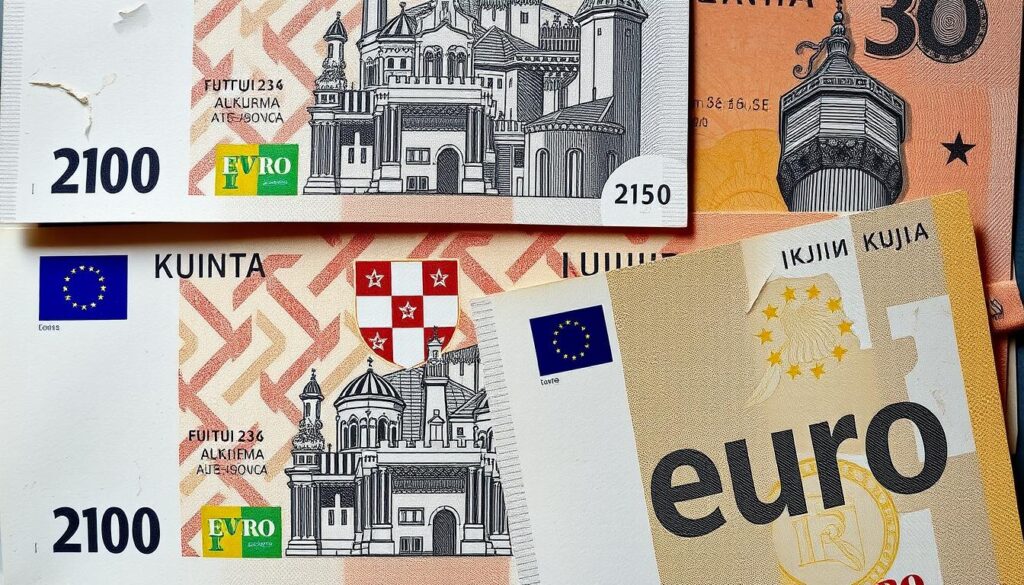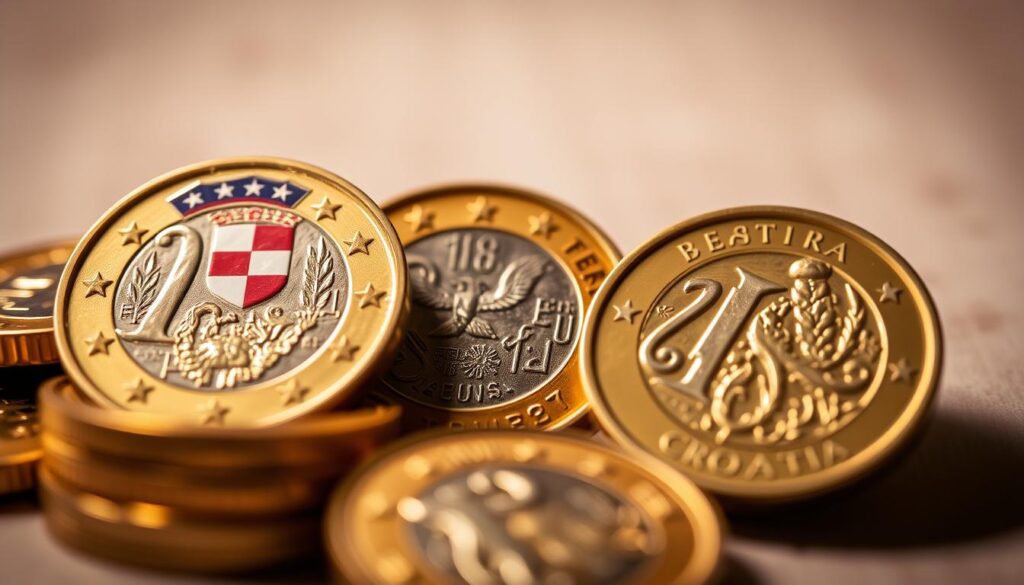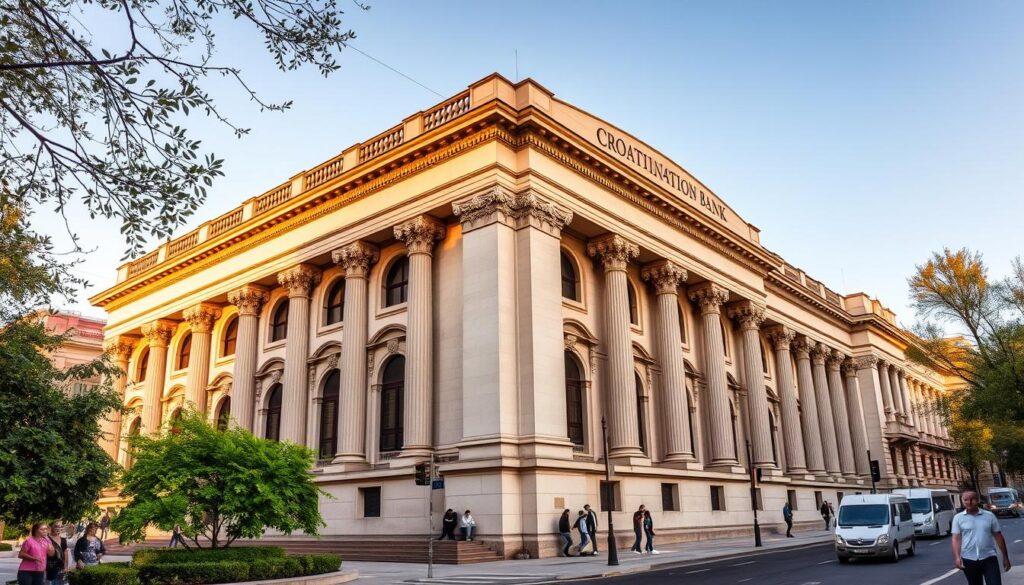
As of January 2023, Croatia officially adopted the Euro as its currency. This change marked a big shift in its monetary system. The Croatian Kuna (HRK) was replaced by the Euro (EUR), making transactions easier for tourists. It also helped integrate Croatia’s economy more into the European Union.
This change is important for both travelers and businesses. You’ll learn about the history of the Croatian Kuna and the new Euro currency. Plus, you’ll get tips on managing your money in Croatia.
Key Takeaways
- Croatia adopted the Euro as its official currency in January 2023.
- The Croatian Kuna was replaced by the Euro, simplifying transactions.
- The Euro is divided into cents and comes in various note and coin denominations.
- Understanding the Croatian monetary system is crucial for travelers and businesses.
- The change integrates Croatia’s economy further into the European Union.
The Current Currency Situation in Croatia
Croatia’s move to the Euro has made it more appealing for trade and tourism. It’s important to know about the key events and their effects.
Croatia’s Historic Euro Adoption in January 2023
Croatia started using the Euro on January 1, 2023. This big change was part of its effort to join the Eurozone. It made Croatia’s economy more stable and attractive to investors.
Dual Circulation Period and Transition Timeline
First, both the Euro and the Croatian Kuna were used. This allowed everyone to get used to the Euro. After January 14, 2023, only the Euro was accepted.
Impact on Tourism and International Trade
The Euro has made Croatia easier for tourists from Eurozone countries to visit. They don’t need to exchange money. For businesses, using the Euro has made transactions simpler and reduced risks.
Understanding these changes is key. It helps whether you’re planning a trip or investing in Croatia.
History of Croatian Currency
Croatia’s currency history is filled with important moments. It started with the Yugoslav Dinar and moved to the Euro. This journey shows how the country’s economy grew and joined the European market.
From Yugoslav Dinar to Croatian Dinar (1991-1994)
Before the Euro, Croatia had the Croatian Kuna from 1994 to 2023. Before that, it used the Yugoslav Dinar during Yugoslavia. After becoming independent in 1991, Croatia briefly had its own currency, the Croatian Dinar, but it wasn’t used much.
The Kuna Era (1994-2022)
The Croatian Kuna was introduced in 1994 and was the official currency for nearly 30 years. It was divided into 100 lipa. The Kuna had banknotes and coins that showed off Croatian culture and history.
Croatia’s Journey to Eurozone Membership
In January 2023, Croatia joined the Eurozone, a big step in its economic ties with Europe. There was a time when both the Kuna and Euro were accepted.
| Currency | Period Used | Notable Features |
|---|---|---|
| Yugoslav Dinar | Before 1991 | Used during the Yugoslav era |
| Croatian Dinar | 1991-1994 | Briefly used after independence |
| Croatian Kuna | 1994-2023 | Featured Croatian culture and history |
| Euro | 2023-present | Marks integration into the Eurozone |
Understanding Croatia Money Type: The Croatian Kuna Legacy
The Croatian Kuna was more than just money. It showed off Croatian culture. Even though it’s gone, replaced by the Euro, its impact on Croatia’s history is still felt.
Kuna Banknotes and Their Cultural Significance
The Kuna was split into 100 lipa. Its banknotes showed off Croatian themes and famous people. These notes were more than money; they were a way to share Croatian heritage.
They had pictures of Croatian landscapes, cultural symbols, and important historical figures. These images made the Kuna banknotes special.
Kuna Coins and Their Denominations
Kuna coins were a big part of Croatia’s money. They came in different values, used every day. Each coin had its own design, showing off Croatian culture and history.
The coins went from 1 lipa to 1 Kuna. Later, even higher values were added.
Collector’s Value of Kuna After Euro Transition
With the Euro now the main currency, Kuna items are sought after by collectors. They see these items as a piece of Croatian history. The value of these items depends on their condition, how rare they are, and how much people want them.
| Denomination | Material | Collector’s Value |
|---|---|---|
| 1 Kuna | Nickel-brass | $5-$10 |
| 5 Kuna | Copper-nickel | $10-$20 |
| 100 Kuna | Silver | $50-$100 |
The Croatian Kuna may be old news, but it still holds cultural and historical value. It’s a favorite among collectors and history buffs.
The Euro as Croatia’s New Official Currency
Croatia has adopted the Euro as its official currency. This move shows its deeper connection to the European economy. You’ll see how this change impacts Croatia’s economy and daily life.

Croatian Euro Coins: Design and National Symbols
Croatian Euro coins mix national identity with European unity. The Croatian National Bank picked designs that show national symbols and motifs. These coins are more than money; they represent Croatia’s history and values.
- The coins have unique Croatian designs, appealing to collectors.
- Each coin has its own design, highlighting different parts of Croatian culture.
Euro Banknotes in Circulation Throughout Croatia
Euro banknotes are used in the Eurozone and are accepted in Croatia. They have architectural styles from European history. This makes them easy to recognize and trust in Croatia.
- €5, €10, €20, €50, €100, €200, and €500 denominations are available.
- The banknotes are secure, with features to stop counterfeiting.
Economic Benefits of Euro Adoption for Croatia
The Euro adoption will bring economic benefits to Croatia. These include lower transaction costs, more trade with Eurozone countries, and better economic stability. This means a more connected and stable economy for Croatia.
- Travel and tourism will be easier without needing to exchange currency.
- Foreign investment will increase with Croatia’s Eurozone membership.
Croatia Exchange Rate Information for Travelers
Planning a trip to Croatia? Knowing the current exchange rates is key to managing your money. Since Croatia uses the Euro, exchanging money is easier. But, it’s still important to keep an eye on the Euro to USD rate, especially if you’re from the United States.
Current Euro to USD Exchange Rates
The Euro to USD exchange rate is vital for travelers. The rate has been changing lately. You can find the latest rates on financial news sites or with currency converter apps.
Keeping an eye on these rates helps you know when to exchange your money.
Historical Kuna Exchange Rate Trends
Before the Euro, Croatia used the Kuna. Knowing the Kuna to USD rate’s past can give clues about future Euro rates. Even though the Kuna is gone, its history can guide us.
Using Currency Converter Apps in Croatia
Currency converter apps are must-haves for travelers. They show real-time rates, helping you make smart money choices. Apps like XE Currency Converter and Google Currency Converter are popular.
Forecasting Exchange Rate Fluctuations
Forecasting exchange rate changes involves looking at the economy, politics, and market trends. It’s hard to guess exact rates. But, staying updated with financial news and expert views can help you guess future changes.
Croatian Monetary System and Central Bank Operations
To grasp the Croatian monetary system, we must look at its central bank’s role. The Croatian National Bank is key, even after Croatia joined the Eurozone.

Role of the Croatian National Bank Post-Euro
The Croatian National Bank is crucial for financial stability in Croatia. Even though Croatia is in the Eurozone, the bank works with the European Central Bank. They make monetary policies that help Croatia.
Croatia’s Monetary Policy Within the Eurozone
Being in the Eurozone means Croatia follows the European Central Bank’s monetary policy. This keeps Croatia’s economy stable and competitive in Europe.
Financial Stability Measures and Regulations
The Croatian National Bank takes steps to keep finances stable. They regulate banks, watch financial markets, and build a strong financial base.
| Measure | Description | Impact |
|---|---|---|
| Bank Regulation | Oversight of banking operations | Ensures bank stability |
| Financial Market Monitoring | Continuous monitoring of financial markets | Prevents market volatility |
| Financial Infrastructure | Maintenance of payment systems | Facilitates smooth transactions |
Knowing the Croatian National Bank’s role and financial stability measures helps you understand Croatia’s monetary system in the Eurozone.
Currency Exchange Options in Croatia
Travelers to Croatia have many ways to exchange currency. You can choose from banks to digital platforms. Knowing these options helps you manage your money well during your trip.
Banks vs. Exchange Offices: Comparing Rates
Banks and exchange offices are the main places to exchange currency. Banks might give better rates for big transactions. Exchange offices, on the other hand, are open longer and in more places. Always check the rates and fees before you decide.
| Exchange Method | Average Rate | Fees |
|---|---|---|
| Banks | 1 EUR = 1.10 USD | 1-2% |
| Exchange Offices | 1 EUR = 1.08 USD | 2-5% |
Airport and Hotel Exchange Services
Exchanging currency at airports or hotels is easy but not the best deal. You’ll get less money and pay more fees. It’s better to exchange a little for immediate needs and use ATMs or digital payments for the rest.
“Using airport or hotel exchange services should be limited to emergency situations due to their unfavorable rates and high fees.”
Using ATMs in Croatia: Fees and Availability
ATMs are everywhere in Croatia, making it easy to get local currency. But, watch out for fees from your bank and the ATM itself.
Digital Payment and Exchange Platforms
Digital payment platforms are getting popular. They offer good rates and lower fees than old ways. Plus, you can manage your money online or through apps.
In conclusion, Croatia has many ways to exchange currency. You can pick what works best for you, whether it’s for convenience, good rates, or low fees.
Banking System in Croatia for American Visitors
As an American visiting Croatia, you’ll find a well-developed banking system. It meets your financial needs. Croatian banks offer services that make managing your money easy during your trip.
Major Banks Operating Throughout Croatia
Croatia has several major banks. They provide services like foreign currency exchange and ATM services. Some well-known banks include Zagrebačka banka, Privredna banka Zagreb, and Erste & Steiermärkische Bank.
| Bank Name | Services for Tourists | English Support |
|---|---|---|
| Zagrebačka banka | Currency exchange, ATM services | Yes |
| Privredna banka Zagreb | Currency exchange, credit cards | Yes |
| Erste & Steiermärkische Bank | ATM services, online banking | Yes |
Banking Hours and Services for Tourists
Banking hours in Croatia are from 8:00 AM to 7:00 PM on weekdays. On Saturdays, they are from 8:00 AM to 1:00 PM. Banks in tourist areas often have longer hours. Most banks speak English, making it easier for American visitors.
Using US Credit Cards and Banking Apps
US credit cards are widely accepted in Croatia, especially in tourist spots. You can also use your banking apps for cash withdrawals or payments.
International Banking Partnerships
Some Croatian banks have partnerships with international banks. This can make transactions easier and reduce fees. It’s wise to check with your bank before traveling to know about any fees or limitations.
Practical Money Tips for American Travelers to Croatia
As you get ready for your trip to Croatia, knowing about the local money and payment habits is key. Croatia is now part of the Eurozone, which means new things to think about for travelers.
Cash vs. Card: Payment Preferences in Different Settings
In Croatia, both cash and cards are accepted, but it depends on where you are. Big places like restaurants, hotels, and shops take major cards like American Express, Visa, and Mastercard. But, smaller places, local markets, and rural areas often want cash.
Tipping Customs and Expectations in Croatia
Tipping in Croatia is less than what Americans tip in the US, but it’s still nice. For dining, a 10% tip is polite. For tour guides, 5-10 Euros a day is standard, based on service quality.
Avoiding Currency Exchange Scams and Fraud
To stay safe, exchange money at banks or use ATMs. Watch out for exchange offices with too-good-to-be-true rates. They might charge high fees or give bad rates. Always check the rates and fees before you do anything.
Emergency Financial Services for Tourists
In emergencies, having access to financial help is crucial. Many Croatian banks offer services for tourists, like help with lost or stolen cards. Also, tell your bank you’re traveling to avoid account issues.
| Service | Average Cost/Tip | Notes |
|---|---|---|
| Restaurant Service | 10% | Polite for good service |
| Tour Guides | 5-10 Euros/day | Standard for good service |
| ATMs | Variable fees | Check with your bank |
Knowing these money tips can make your trip to Croatia better. Enjoy your time there!
Regional Currency Practices Across Croatia
Traveling across Croatia shows you how different currency practices can be. This difference comes from tourism, local business ways, and where you are.
Currency Usage in Zagreb vs. Coastal Tourist Areas
In Zagreb, you’ll see both old and new ways to pay. Cash is still best for small buys. But, coastal tourist areas like Dubrovnik and Split take more payment types. This is because they get lots of visitors from abroad.
Rural Croatia and Currency Acceptance
In rural areas, cash is the top choice. Small shops and markets often only take cash. So, it’s smart to carry local money.
Border Regions and Multi-Currency Flexibility
Border regions are more open to different currencies. For example, places near Slovenia might take euros more often.
Island Economies and Payment Systems
Islands like Hvar and Korčula have learned to accept many payment types. But, it’s good to have cash too. This is true for small places or off-peak times.
Knowing these regional differences makes traveling in Croatia easier. It helps you have a better trip.
Conclusion
When planning your trip to Croatia, knowing about the currency is key. The Euro’s adoption has made money matters easier for everyone. You can now easily explore places like Zagreb, enjoy the islands, or see the national parks.
With the Euro, you don’t need to exchange money, which simplifies your spending. You can pay with your card almost everywhere. Also, ATMs are easy to find. Knowing the exchange rates and having some local money for the start of your trip will help a lot.
Learning about Croatia’s currency history and system, and getting some money tips, will improve your trip. Whether you want to try local food, see cultural spots, or enjoy nature, being ready will make your visit better.
FAQ
What is the official currency of Croatia?
The official currency of Croatia is the Euro. It was adopted in January 2023, replacing the Croatian Kuna.
What was the Croatian Kuna, and why was it replaced?
The Croatian Kuna was Croatia’s currency from 1994 to 2022. It was replaced by the Euro. This move was part of Croatia joining the European Union and the Eurozone.
How did the transition from Kuna to Euro affect tourism in Croatia?
The Euro made things easier for tourists. It cut down on the hassle of exchanging money. This made Croatia more appealing to European visitors, boosting tourism.
Are Kuna banknotes and coins still valid?
No, the Kuna is no longer used as money. But, Kuna banknotes and coins are now collectibles. They hold value as a piece of Croatian history.
What are the unique features of Croatian Euro coins?
Croatian Euro coins have special designs and symbols. Euro banknotes, however, are the same across the Eurozone.
How can I exchange my money for Euros when traveling to Croatia?
You can exchange your money at banks, exchange offices, or ATMs. Digital payment platforms also offer a convenient way to manage your money.
Are US credit cards widely accepted in Croatia?
Yes, US credit cards are widely accepted in Croatia. This makes it easy for American tourists to handle their finances.
What are some practical money tips for travelers to Croatia?
Knowing when to use cash or cards is key. Being aware of tipping customs and avoiding scams can greatly enhance your trip.
How does the Croatian National Bank function within the Eurozone?
The Croatian National Bank works with the European Central Bank. They ensure financial stability and implement policies that benefit Croatia.
Are there any regional differences in currency practices across Croatia?
Yes, payment methods vary across Croatia. From Zagreb to coastal areas and rural regions, knowing these differences helps you navigate better.
Can I still use currency converter apps to manage my money in Croatia?
Yes, currency converter apps are still useful. They help you make smart money decisions, especially when watching the Euro to USD rate.

Adam G
This post was created by Adam G, a seasoned financial writer with a passion for explaining currency exchange and market movements
